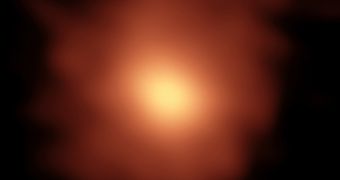In a paper published in yesterday's issue of the Astrophysical Journal Letters, an international team of researchers explain that, according to evidence at hand, it is possible for organic molecules to form in comets' atmospheres.
The paper details how, while busy studying the atmospheres surrounding comets ISON and Lemmon with the help of ALMA (the Atacama Large Millimeter/sub-millimeter Array), scientists identified three different types of organic molecules.
In case anyone was wondering, comet ISON and its atmosphere were observed between November 15 and 17, 2013. At that time, the comet was located at a distance of about 75 million kilometers (46.6 million miles) from the Sun.
Comet Lemmon, on the other hand, was monitored on June 1 and 2, 2013. Astronomers say that, at the time they observed its atmosphere with ALMA's help, the comet sat at a distance of roughly 224 million kilometers (139.2 million miles) from the Sun.
As detailed on the official website for the National Radioastronomy Observatory, the three important organic molecules mapped in the atmospheres surrounding ISON and Lemmon were as follows: hydrogen cyanide (HCN), hydrogen isocyanide (HNC), and formaldehyde (H2CO).
Of these molecules, HCN ones were found to flow outward from the nucleus. They moved in all directions, and displayed fairly even patterns of distribution. The HNC molecules, on the other hand, were found to stick together in clumps and jets.
Based on data obtained during this research project, it is now said that HNC and H2CO can both form within a comet's coma, and that HNC most likely results from the breakdown of somewhat bigger molecules, maybe even organic dust.
Commenting on the outcome of this investigation, team leader Martin Cordiner with NASA's Goddard Space Flight Center in Greenbelt, Maryland, pointed out that “We achieved truly first-of-a-kind mapping of important molecules that help us understand the nature of comets.”
“Understanding organic dust is important, because such materials are more resistant to destruction during atmospheric entry, and some could have been delivered intact to the early Earth, thereby fueling the emergence of life.”
“These observations open a new window on this poorly known component of cometary organics,” added researcher Michael Mumma, director of the Goddard Center for Astrobiology and a co-author of the study published in the Astrophysical Journal Letters this past August 11.
Interestingly enough, this research project was the first to use Earth-based telescopes to study comets of a moderate brightness. Thus, specialists with the National Radioastronomy Observatory and colleagues explain that most other investigations of this kind have so far focused on very bright comets.

 14 DAY TRIAL //
14 DAY TRIAL //